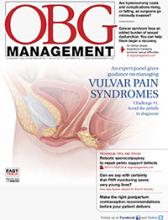“NOT ALL CONTRACEPTIVES ARE SUITABLE IMMEDIATELY POSTPARTUM”
ROBERT L. BARBIERI, MD (EDITORIAL; SEPTEMBER 2011)
The IUD is an option for postpartum placement
Dr. Barbieri did a great job of summarizing the latest recommendations from the Centers for Disease Control and Prevention (CDC) and highlighting the options for postpartum contraception. I have never inserted an intrauterine device (IUD) immediately after delivery, but it is nice to know of the option.
Jackie Garrard, MD
Boulder, Colo
Risk of expulsion is too high to make the IUD practical
Given the cost of an IUD ($600–$700), the 12% to 25% risk of it falling out after postpartum placement is unacceptable. Try convincing the insurance company or Medicaid that they should pay for another one.
Suzanne Merrill-Nach, MD
San Diego, Calif
Dr. Barbieri responds IUD is cost-effective
I thank Dr. Garrard and Dr. Merrill-Nach for taking time from their busy schedules to write to OBG Management about important patient-care issues. Slowing the rise of health-care costs is an important goal in the United States. Cost-benefit analyses suggest that, even after accounting for the risk of expulsion of an expensive IUD, it is cost-effective to consider placement. The advantage of the IUD is that it results in fewer deliveries during the follow-up interval, thereby saving the cost of additional obstetric and newborn care.
At our institution, we have recently seen a decrease in the use of postpartum sterilization and a significant increase in the use of Implanon, inserted while the patient is on the postpartum floor, before discharge home. Once implanted, the Implanon device cannot be expelled or discontinued by the patient without the involvement of a clinician.
“DOES THE USE OF MULTIPLE MANEUVERS IN THE TREATMENT OF SHOULDER DYSTOCIA INCREASE THE RISK OF NEONATAL INJURY?”
ROBERT B. GHERMAN, MD (EXAMINING THE EVIDENCE; AUGUST 2011)
Severe shoulder dystocias are more likely to require multiple maneuvers
Both the study of obstetric maneuvers for the acute management of shoulder dystocia and Dr. Gherman’s review of it ignored the fact that severe and difficult shoulder dystocias are severe and difficult. Naturally, if a dystocia is severe, it is less likely that the first maneuver will be effective at resolving it. Rather, another maneuver will be necessary.
I would conclude that more severe dystocias are more likely to require additional maneuvers to alleviate and also more likely to result in fetal injury. I would not assume that the increased number or the type of maneuvers used was the cause of injury. In fact, given that one third of brachial plexus injuries occur in the posterior shoulder, and another third occur when there is no dystocia at all, it seems most likely that nearly all such injuries are the result of forces and stresses that were present in labor before the delivering clinician touched the baby—and are not a result of maneuvers.1-3
My personal experience, and that of my two partners, has strongly borne out the utility of delivering the posterior arm as an excellent second maneuver after McRobert’s maneuver. In the large majority of cases, I am able to deliver the arm, which leads to delivery of the infant in 100% of cases. In a few cases, when the posterior arm is straight at the fetus’ side and the hand is inside the uterus, I may be unable to deliver the arm. Nevertheless, an attempt usually succeeds in rotating the fetus’ shoulders, accomplishing a partial Wood’s screw maneuver concurrently, and often allows delivery of the anterior shoulder with another maternal push.
The bottom line: More severe shoulder dystocias are more likely to require multiple procedures and also more likely to result in fetal injury. McRobert’s maneuver and delivery of the posterior arm are an excellent place to start.
David H. Janowitz, MD
Houston, Tex
We want to hear from you! Tell us what you think.


